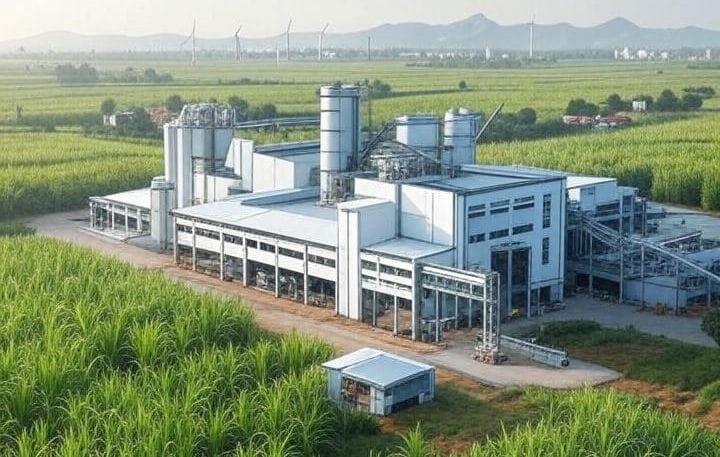In recent years, India has accelerated its push towards sustainable energy solutions, with ethanol blending emerging as a key strategy. This initiative involves mixing ethanol, derived primarily from agricultural feedstocks like sugarcane and grains, with petrol to create a cleaner-burning fuel. By August 2025, India has successfully achieved an average ethanol blending rate of around 19-20%, meeting its ambitious E20 target well ahead of the initial timeline. 19 This progress not only reduces the country’s reliance on imported fossil fuels but also creates significant opportunities for domestic industries, particularly those involved in ethanol production.
India’s Ethanol Blending Journey: Policies and Milestones
The Indian government launched the Ethanol Blended Petrol (EBP) program in 2003, but it gained real momentum under the National Policy on Biofuels in 2018. The target was initially set at 20% blending by 2030, but in 2021, it was advanced to 2025 to align with broader goals of energy security and environmental protection. 47 By mid-2025, the nation had already hit this mark, with blending levels reaching 19.05% as of July. 17 This rapid advancement was supported by incentives for distilleries, fixed pricing for ethanol procurement, and diversification of feedstocks to include rice, corn, and damaged grains.
Key milestones include:
- Blending rising from just 1.5% in 2014 to 20% in 2025. 36
- Record diversion of surplus rice (5.2 million tons) for ethanol production to manage food stocks and support blending goals. 40
- Savings of approximately ₹1.44 lakh crore in foreign exchange due to reduced crude oil imports. 17
Looking ahead, discussions are underway for higher targets, such as 25-30% blending by 2030, which could further expand the program’s scope. 25
Economic and Environmental Benefits
Ethanol blending offers multifaceted advantages. Economically, it bolsters rural incomes by providing a stable market for farmers’ produce. Sugarcane farmers, in particular, have benefited from direct payments exceeding ₹1.18 lakh crore since the program’s intensification. 26 This has helped stabilize sugar prices and reduced excess stockpiles in government reserves.
On the environmental front, the initiative cuts greenhouse gas emissions by promoting a renewable alternative to petrol. Estimates suggest that blending has already averted millions of tons of CO2 releases, contributing to India’s net-zero ambitions by 2070. 39 Additionally, it enhances energy independence, saving billions in import costs that would otherwise flow to oil-producing nations. 29
Impact on Ethanol-Producing Stocks
The surge in ethanol demand has been a boon for companies in the sugar and distillery sectors, many of which have pivoted to ethanol production for higher margins. With the government mandating increased blending, these firms have seen expanded capacities and revenues.
Prominent players include:
- Balrampur Chini Mills: A leading sugar producer that has ramped up ethanol output, benefiting from favorable procurement prices.
- Shree Renuka Sugars: Focused on integrated operations, it has capitalized on the ethanol push, with stock performance reflecting policy tailwinds.
- Triveni Engineering & Industries: Diversified into ethanol, showing strong growth amid rising blending targets.
- E.I.D. Parry (India): Part of the Murugappa Group, it has invested heavily in distillery expansions.
- Praj Industries: Specializing in ethanol plant technology, it stands to gain from infrastructure buildouts. 37 38 0
Stock market trends indicate positive momentum. For instance, the ethanol market in India, valued at over $6.5 billion in 2023, is projected to reach $10.45 billion by 2029, growing at nearly 9% annually. 46 Companies like Bajaj Hindusthan and Dwarikesh Sugar have also reported improved financials due to ethanol sales, with investor interest spiking as blending targets were met early. 42 However, volatility remains, influenced by feedstock availability and global sugar prices.
Challenges and Considerations
Despite the successes, challenges persist. Critics highlight the “food vs. fuel” dilemma, where diverting crops like rice and corn for ethanol could strain food supplies and inflate prices. 40 Water-intensive sugarcane cultivation raises concerns about resource scarcity in drought-prone areas. 16 For consumers, E20 fuel may reduce vehicle mileage by 1-6%, depending on the model, and older vehicles (pre-2023) face compatibility issues, potentially leading to higher maintenance costs. 24 27
To mitigate these, the government is encouraging second-generation ethanol from non-food biomass and promoting flex-fuel vehicles.
Looking Forward: A Sustainable Path
Ethanol blending represents a strategic shift towards greener mobility in India, fostering economic growth while addressing climate goals. For investors, ethanol-producing stocks offer promising avenues, driven by policy support and market expansion. As India eyes even higher blending ratios, balancing innovation with sustainability will be crucial to maximizing benefits for all stakeholders.
By staying informed on these developments, students and young professionals can explore careers in renewable energy, agribusiness, and finance—sectors poised for transformation in India’s green economy.



Average Rating